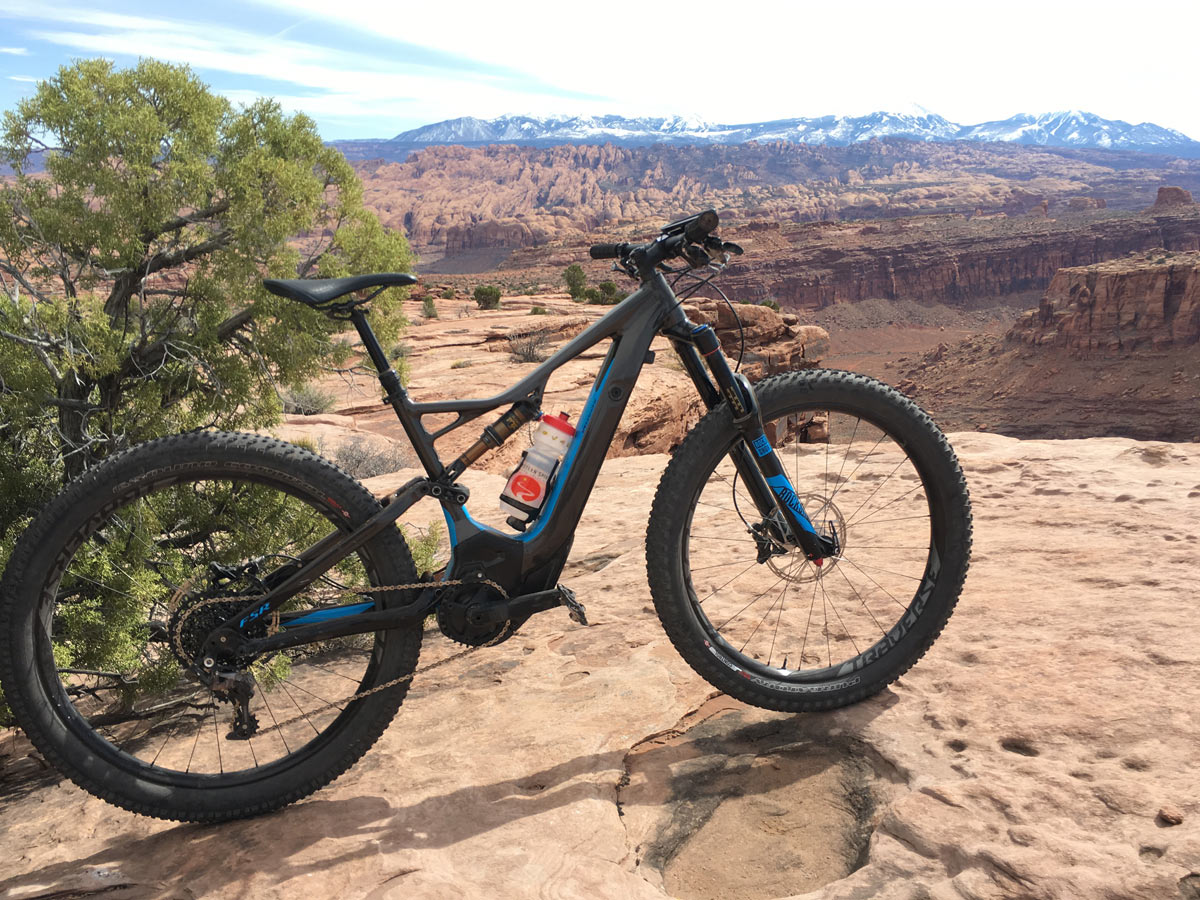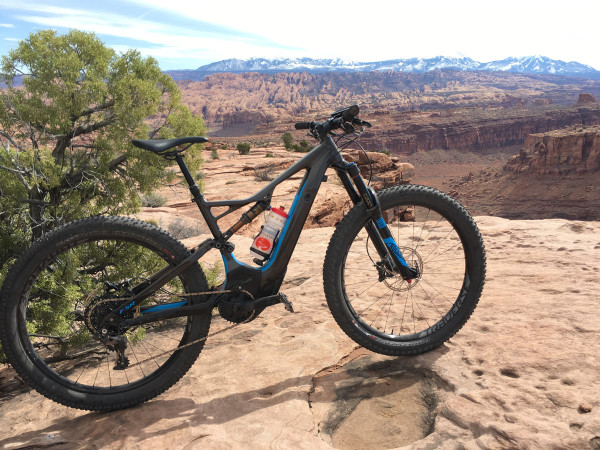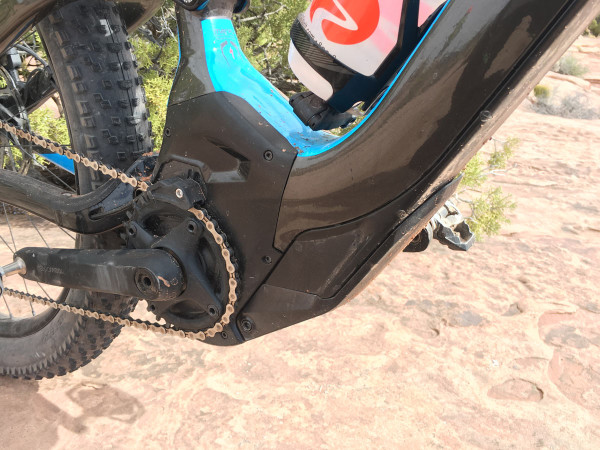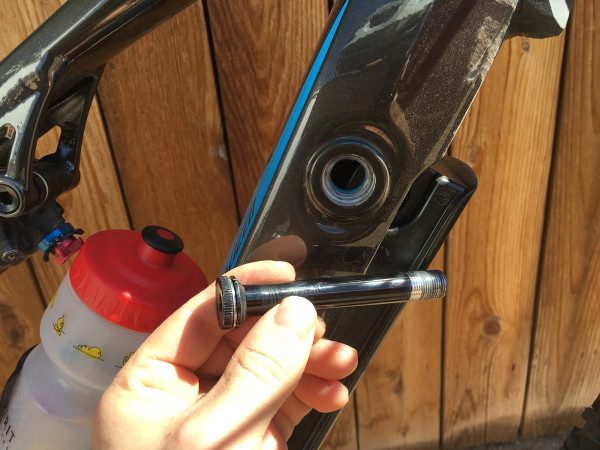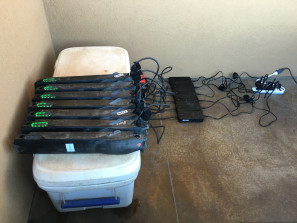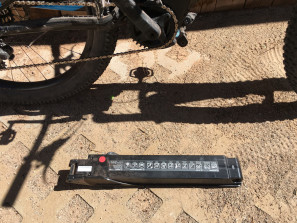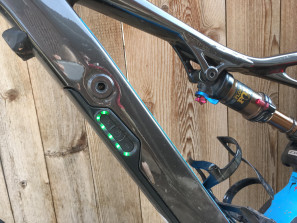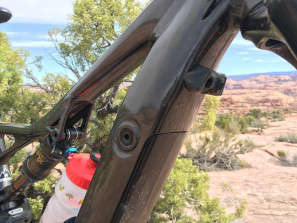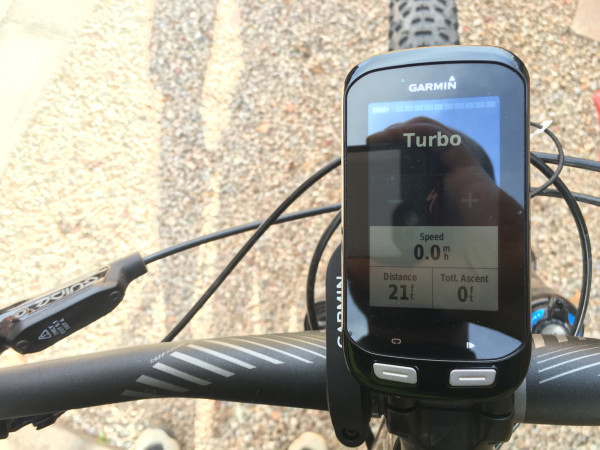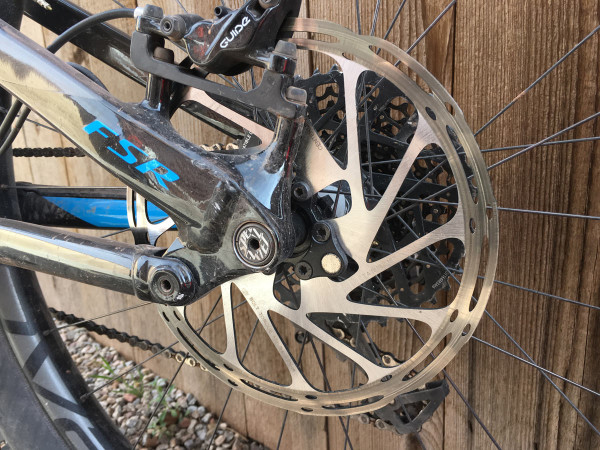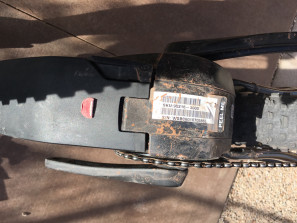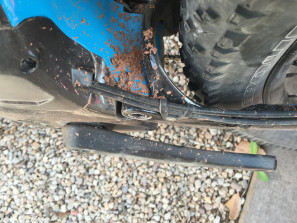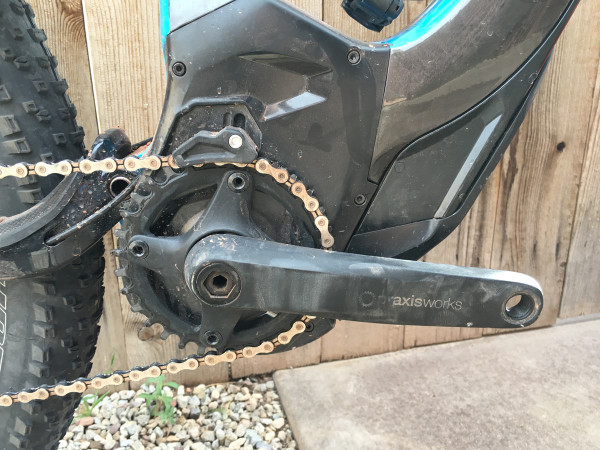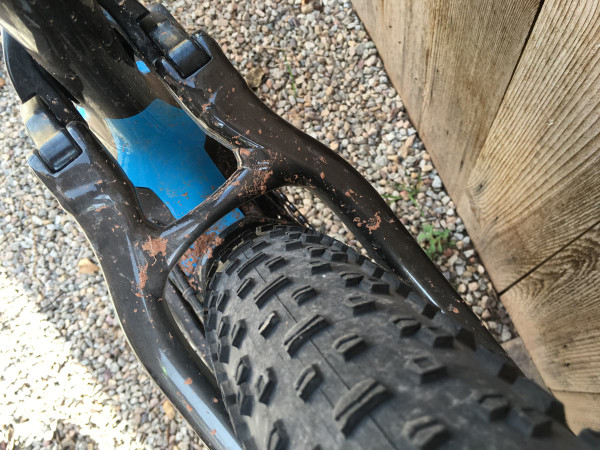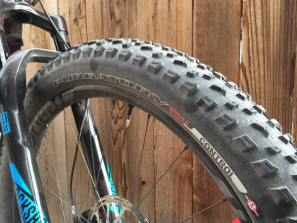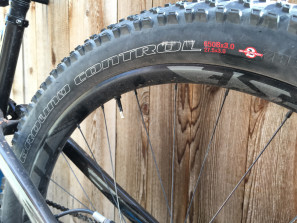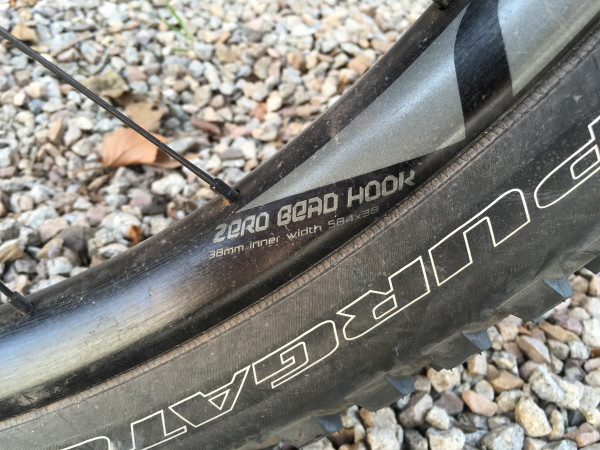If you’re just seeing this and wonder what we’re doing with an e-bike in Moab, read this first. Now that that’s out of the way, let’s talk about the actual bike. Specifically the Specialized Turbo Levo FSR 6Fattie. This bike’s story actually starts around 5 years ago when Specialized launched their first e-bike, the Turbo S. At that point even Specialized’s founder Mike Sinyard wasn’t convinced that e-bikes were a way forward, pointing out that the impetus actually came from a small team of their engineers in Switzerland. It wasn’t long before the Turbo S far exceeded their expectations though, and new offices were built in Switzerland more or less specifically for their Turbo line. With the street focused Turbo S selling like hotcakes, it was time to focus on a new challenge.
A Turbo mountain bike.
In typical Specialized fashion though, this couldn’t be just another mountain bike with a battery and motor slapped on it. No, it needed to look and ride like a Specialized Stumpjumper just with a little extra ‘jump’. The end result is the Turbo Levo FSR 6Fattie. A mouthful of a name, Turbo is the encompassing brand name for all of the Specialized e-Bikes while Levo is the name of their mountain e-bike category. With hardtails, FSR full suspension, and even fat bikes getting the Turbo Levo treatment, we spent two days on the Turbo Levo FSR Expert 6Fattie to figure out what makes these beasts whir….
As it turns out, when you set out to build an e-bike, much like a regular bike you have two choices. You can either build the bike with off the shelf components – motors, batteries, bottom bracket forgings, etc., or you can start from the ground up. Specialized claims that during the development of the Levo FSR their goal was to create a mountain bike with pedal assist built in, not an e-bike with mountain bike tires. That may sound like splitting hairs, but what they really wanted was to retain that classic Specialized handling and mountain bike feel with the addition of the pedal assist which included a short 459mm chain stay.
For their engineers, that meant a completely custom design with their own motor and batteries that could be cleanly integrated into the frame. Custom batteries were built to keep the silhouette of a solid down tube – as well as allow space for a water bottle. A custom motor was sourced that wasn’t the most powerful on the market at 250w/530w max, but was nearly silent and could be tuned to the desired torque curves. Basically hidden under the plastic motor shroud is the motor brace that Specialized claims is their largest forging to date. Imagine a donut with a brace in the middle to provide the stiffness needed to harness the combined power of the rider and the motor.
Just as important as the motor, the battery plays an important part in not only the bike’s range, but how it looks. In this case, Specialized has two different batteries – one for the S-Works and Expert models with 504Wh and a slightly lower 460Wh battery for the Comp and below. Each battery is built with 40 cells in two rows, 20 on top and 20 on bottom. The larger watt hour batteries use a 3.5v cell which Specialized says is the same cell used on the Tesla model S, only the Tesla uses 6-7k cells versus the Levo’s 40! Smaller capacity batteries use a 3.2v cell, but the two batteries are interchangeable so if you purchase a bike with one of the lower watt hour batteries you could upgrade to the longer lasting model. You’ll probably want to do this anyways as we found one of the biggest benefits to the Levo was being able to ride huge miles, but we needed two batteries a day to do it.
The Turbo Levo differs from many e-bikes we’ve seen in that the battery actually bolts onto the frame with a mini 15mm thru axle. This was done for a reason – rattling batteries suck. It turns out that the Levo is the quietest e-bike we’ve ridden (which admittedly isn’t that many), so it would be awful to ruin that with a battery that clattered down the trail. The battery loads into the bottom of the frame with a cam-lock mount and then threads into place, though it isn’t a stressed member so you can ride the bike without a battery in place. Why would you want to do that? The battery makes up 8 lbs or so of the bike’s total heft (somewhere around 20-22kg/44-48lbs, with the motor weighing 3400g), so if you had a choice between pedaling around with a dead battery or getting rid of it for the ride home it might not be such a bad idea.
As for total battery life, Specialized estimates that each battery should be at 100% performance for roughly 700 complete charge cycles. That means if you were to completely deplete the battery every day, you’d get almost two years out of the battery before it’s capacity diminished. That’s a lot of riding. At that point the battery would still work, but it would be like an old laptop that just doesn’t hold a charge like it used to and could be recycled and replaced with a new battery.
However, the chances of you actually running out of battery on a ride are pretty slim – especially if you make use of (even more) electronic aides. To be clear, the Turbo Levo was designed to be as simple as possible and allow for use without any additional displays or electronics. Initially, Specialized wanted a clean handlebar. It looks better, and when you crash – displays break. Everything you need to control the pedal assist is located on the key pad on the down tube. The center button powers up the system and the + and – buttons add or subtract assist levels. Surrounding those buttons are 10 LEDs which correspond to 10% battery life each. As the battery level drops, LEDs go out until you get to the last two which will turn red to indicate 20% power. Since these are pedal assist bikes, there is no additional throttle controls to worry about. It only moves when you pedal.
If you’re the type to constantly worry about your range however, Specialized has you covered with a surprisingly comprehensive app (available in Android or iOS). Specialized Mission Control is exactly as it sounds – a complete control unit for the bike which allows you to diagnose issues, track your rides including how much power you are putting out (not just the motor – the bike includes a free powermeter!), and most importantly, tune the pedal assist performance all thanks to Bluetooth and ANT+ connectivity built into the battery. This allows you to physically set the level of assist for each level. While the stock setting is 20% for Eco, 50% for Trail, and 100% for Turbo, you could set it to 10/20/30% if you wanted, or any combination of settings. You can also enable Smart Control which should eliminate “range anxiety.” Say you want to ride 30 miles and get back to the house with 20% battery – punch in those numbers to Smart Control and the motor will continuously monitor your progress every 10 seconds to make sure you make it home with the desired battery life by changing the power settings on the fly. It’s even GPS enabled so it will work with the upcoming terrain if you’re riding an installed route on the GPS. There’s not much worse than limping a 45lb dead e-bike back home so having this feature available seems invaluable.
As for battery life or range, it’s difficult to pin down as it’s all dependent on what mode you have it set in (off, Eco, Trail, or Turbo) how fast you ride, riding style, incline, etc. However, we were finishing challenging 2.5 – 3.5hr rides consistently with 20-40% battery life from rider to rider. This included a lot of Turbo use on the road which really eats up battery life, and plenty of sessioning fun sections of trail along the way. Our longest ride which was around 27-28 miles and 3.5 hrs, which for me was split between Trail and Turbo for the road and I finished with about 30% battery. Batteries can be charged on the bike, or you can remove it to charge if your outlet is far away from your bike storage or you just have multiple batteries. A full charge is said to take only 3.5 hours.
Further control is available through Garmin Connect IQ which will put the Turbo controls on your handlebar if you have an Edge 520, 1000, or Explore 1000. Initially launched in 2014, Connect IQ was Garmin’s way of offering an open app to developers to allow users to download data fields onto their wearables. In this case it also allows you to place the Levo control panel on the screen of your Garmin and even take advantage of the Edge remote to control the bike’s settings and offer a blinking red light for the battery indicator. It also allows you to set up fake channels so you could use a device that is set up to show heart rate or cadence and display the Levo’s battery percentage. At the moment, this is the only way to control the Levo from the handlebar, though you can reach down to the downtube at any time. In practice, it was nice to be able to change the bike’s settings on the fly without fumbling for the controls on the downtube, but in reality I rode almost exclusively in Trail mode, only bumping it up to turbo mode on the road (or on Slickrock).
In order to work, every e-bike has to sense both speed an torque. Torque is sensed within the motor at the crank, but speed is a little more difficult. Specialized didn’t like how most e-bikes use essentially a spoke magnet with a speed sensor bolted onto the chainstay, so they found a better way. The magnet is now attached directly to the brake rotor with the sensor hidden in the dropout. That makes the system a lot more robust and less prone to getting kicked or knocked off after a crash. It is important to know that without this magnet though, the system will not work – a fact Specialized employees were reminded of when they once swapped wheels after a flat.
Even with the massive battery and motor attached to the downtube, the frame is surprisingly resilient. In testing the battery has to withstand a 5kg strike test, and we did our own strike testing of the motor housing on the trail. Turns out it works pretty well as a bash guard! The battery actually has a skid plate built in, but Specialized says it’s not really needed since the battery is so robust. Also, while not recommended for complete submersion, the system is IP67 certified which means it’s waterproof to 1 meter and is safe for washing, riding through creeks, or being on your bike rack through a rain storm.
Most of what sets the Levo apart is actually hidden inside the motor housing. Using a 3:1 gear reduction to increase torque, the 250w motor drives a toothed pulley on the crank with a Gates belt drive which is why the motor is so quiet. Apparently many other motors use direct gearing which is where that signature e-bike whine comes from. Only when the motor was under extreme torque in the lowest gears trying to go up a super steep pitch was the motor noise actually noticeable – otherwise all you heard was the typical drivetrain and tire noise. The Specialized motor also uses two sprague clutches – one on the crank and one on the motor. This makes it so that when you are pedaling without the motor engaged, you are only pedaling the drivetrain without any extra drag from the motor. Pedaling around downtown Moab with the motor off just felt like pedaling a really heavy bike. I wouldn’t want to do it up a mountain, but it wasn’t much different than pedaling one of my old downhill bikes.
Each bike also uses a custom crankset from Praxis Works along with a steel narrow-wide chainring. The steel ring is used for obvious reasons to cut down on wear, though Specialized claims drivetrain wear has been similar to what they’ve seen on the spectrum of classic bikes. Technically the crank uses a standard BCD so you could change the ring (within the confines of the built in chainguide), but with the pedal assist Specialized expects most riders to be happy with the 32t ring. The cranks are also a good bit shorter than what you’ll find on a classic bike (down to 165mm) along with a 7mm higher bottom bracket. This is all in an attempt to prevent you from snagging a pedal under full power, which has an all new level of danger when a motor is involved. They must have figured it out, because I didn’t notice pedal strike being an issue on any of the techy trails in Moab.
Elsewhere, it’s just a normal FSR 6Fattie. Built with a good amount of rear tire clearance, our test bikes were set up with 6Fattie Purgatory and Ground Control 27 x 3.0″ tires with the more durable Control casings on 38mm internal width Roval Traverse alloy rims. Considering Moab’s terrain, the set ups worked incredibly well with only a few flats that were confined to the few hard tails in the mix. As much as this was an e-bike test, it was also an eye opening experience for the use of plus size tires. Between the additional grip, control, and confidence they provided on Moab’s varying conditions, motor or not, they were impressive. Specialized engineers actually claim there is a 69% greater contact patch with a 3.0″ tire at 18 psi compared to a 2.3″ tire at 24 psi. On paper that’s a bit hard to believe, but it’s a lot more believable once you hit the trail.
Other component highlights includes a RockShox Pike RC 140mm fork, and a custom Fox Float Factory DPS rear shock with Autosag and their RX trail tune that did a fantastic job keeping the 135mm of rear travel in check. Braking duties were taken care of through the SRAM Guide RS, though all the bikes feature upsized rotors with 200mm front/ 180mm rear and I can assure you we needed every bit of those brakes.
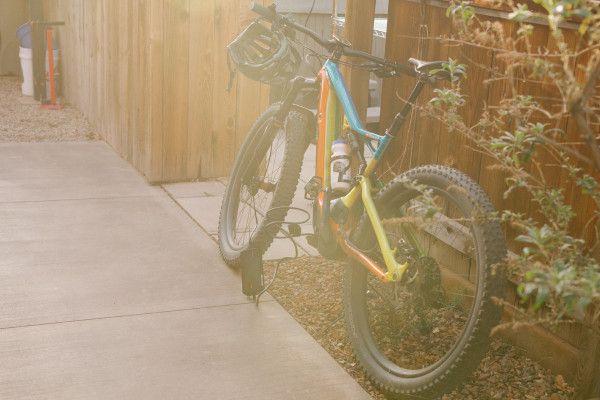
Turbo Levo FSR 6Fatties will be sold in S-Works, Expert, and Comp builds which all utilize the same M5 Premium Aluminum frame with 140/135mm of travel. The Turbo Levo FSR Comp 6Fattie is also offered in a women’s version along with the Turbo Levo HT 6Fattie which is offered in men’s and women’s. The Turbo HT Comp Fat comes in a single build with pedal assist and 4.6″ tires. U.S. pricing is yet to be determined, though from the possible figures we’ve heard, it’s not as steep as you might think. Sold with a 2 year, 1,500 km warranty, the Turbo Levo FSR 6Fattie series will soon be available in the U.S. but only in limited quantities.
Update: Specialized just released the U.S. pricing for their Turbo Levo line, with full suspension bikes starting at $5,500.
- Women’s Hardtail Comp 6Fattie: $4000
- Women’s FSR Comp 6Fattie: $5500
- HT Comp Fat: $5000
- HT Comp 6Fattie: $4000
- FSR Comp 6fattie: $5500
- FSR Expert 6Fattie: $7500
- FSR S-Works 6Fattie: $9500
